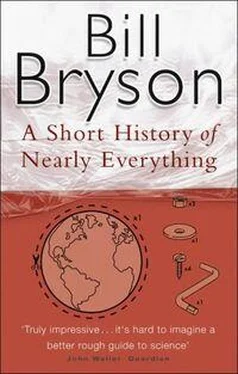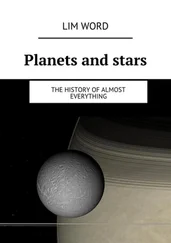“equivalent to the world’s output of coal . . .” Trefil, Meditations at 10,000 Feet , p. 122.
“a lag in the official, astronomical start of a season . . .” Stevens, p. 111.
“how long it takes a drop of water . . .” National Geographic , “New Eyes on the Oceans,” October 2000, p. 101.
“about twenty thousand times as much carbon . . .” Stevens, p. 7.
“the ‘natural’ level of carbon dioxide . . .” Science, “The Ascent of Atmospheric Sciences,” October 13, 2000, p. 303.
CHAPTER 18 THE BOUNDING MAIN
“a world dominated by dihydrogen oxide . . .” Margulis and Sagan, p. 100.
“A potato is 80 percent water . . .” Schopf, p. 107.
“Almost nothing about it can be used . . .” Green, p. 29; and Gribbin, In the Beginning , p. 174.
“By the time it is solid . . .” Trefil, Meditations at 10,000 Feet , p. 121.
“an utterly bizarre property . . .” Gribbin, In the Beginning , p. 174.
“like the ever-changing partners in a quadrille . . .” Kunzig, p. 8.
“only 15 percent of them are actually touching.” Dennis, The Bird in the Waterfall , p. 152.
“Within days, the lips vanish . . .” Economist , May 13, 2000, p. 4.
“A typical liter of seawater will contain . . .” Dennis, p. 248.
“we sweat and cry seawater . . .” Margulis and Sagan, pp. 183-84.
“There are 320 million cubic miles of water . . . ” Green, p. 25.
“By 3.8 billion years ago . . . ” Ward and Brownlee, p. 36.
“Altogether the Pacific holds just over half . . .” Dennis, p. 226.
“we would better call our planet not Earth but Water.” Ball, p. 21.
“Of the 3 percent of Earth’s water that is fresh . . .” Dennis, p. 6; and Scientific American , “On Thin Ice,” December 2002, pp. 100-105.
“Go to the South Pole and you will be standing . . . ” Smith, p. 62.
“enough to raise the oceans . . .” Schultz, Ice Age Lost , p. 75.
“driven to distraction by the mind-numbing routine . . .” Weinberg, A Fish Caught in Time , p. 34.
“But they sailed across almost seventy thousand nautical miles . . .” Hamilton-Paterson, The Great Deep , p. 178.
“female assistants whose jobs were inventively described . . .” Norton, p. 57.
“Soon afterward he teamed up with Barton . . .” Ballard, The Eternal Darkness , pp. 14-15.
“The sphere had no maneuverability . . .” Weinberg, A Fish Caught in Time , p. 158, and Ballard, p. 17.
“Whatever it was, nothing like it has been seen since . . .” Weinberg, A Fish Caught in Time , p. 159.
“In 1958, they did a deal with the U.S. Navy . . .” Broad, The Universe Below , p. 54.
“We didn’t learn a hell of a lot from it . . . ” Quoted in Underwater magazine, “The Deepest Spot On Earth,” Winter 1999.
“the designers couldn’t find anyone willing to build it.” Broad, p. 56.
“In 1994, thirty-four thousand ice hockey gloves . . . ” National Geographic , “New Eyes on the Oceans,” October 2000, p. 93.
“perhaps a millionth or a billionth of the sea’s darkness.” Kunzig, p. 47.
“tube worms over ten feet long . . .” Attenborough, The Living Planet , p. 30.
“Before this it had been thought . . .” National Geographic , “Deep Sea Vents,” October 2000, p. 123.
“enough to bury every bit of land . . . ” Dennis, p. 248.
“it can take up to ten million years . . .” Vogel, p. 182.
“our psychological remoteness from the ocean depths . . .” Engel, The Sea , p. 183.
“When they failed to sink . . .” Kunzig, pp. 294-305.
“Blue whales will sometimes break off a song . . . ” Sagan, p. 225.
“Consider the fabled giant squid.” Good Weekend, “Armed and Dangerous,” July 15, 2000, p. 35.
“as many as thirty million species . . . ” Time , “Call of the Sea,” October 5, 1998, p. 60.
“Even at a depth of three miles . . .” Kunzig, pp. 104-5.
“Altogether less than a tenth of the ocean . . . ” Economist survey, “The Sea,” May 23, 1998, p. 4.
“doesn’t even make it into the top fifty . . .” Flannery, The Future Eaters , p. 104.
“Many fishermen ‘fin’ sharks . . .” Audubon , May-June 1998, p. 54.
“nets big enough to hold a dozen jumbo jets.” Time , “The Fish Crisis,” August 11, 1997, p. 66.
“We’re still in the Dark Ages.” Economist , “Pollock Overboard,” January 6, 1996, p. 22.
“Perhaps as much as twenty-two million metric tons . . . ” Economist survey, “The Sea,” May 23, 1998, p. 12.
“Large areas of the North Sea floor . . .” Outside , December 1997, p. 62.
“By 1990 this had sunk to 22,000 metric tons . . .” Economist survey, “The Sea,” May 23, 1998, p. 8.
“Fishermen . . . had caught them all.” Kurlansky, Cod , p. 186.
“had not staged a comeback” Nature , “How Many More Fish in the Sea?” October 17, 2002, p. 662.
“‘fish’ is ‘whatever is left.’ ” Kurlansky, p. 138.
“90 percent of lobsters are caught . . .” New York Times magazine, “A Tale of Two Fisheries,” August 27, 2000, p. 40.
“As many as fifteen million of them . . . ” BBC Horizon transcript, “Antarctica: The Ice Melts,” p. 16.
CHAPTER 19 THE RISE OF LIFE
“After a few days, the water in the flasks . . .” Earth , “Life’s Crucible,” February 1998, p. 34.
“Repeating Miller’s experiments . . . ” Ball, p. 209.
“as many as a million types of protein . . .” Discover , “The Power of Proteins,” January 2002, p. 38.
“the odds against all two hundred . . .” Crick, Life Itself , p. 51.
“Hemoglobin is only 146 amino acids long . . .” Sulston and Ferry, The Common Thread , p. 14.
“DNA is a whiz at replicating . . .” Margulis and Sagan, p. 63.
“If everything needs everything else . . . ” Davies, p. 71.
“some kind of cumulative selection process . . .” Dawkins, The Blind Watchmaker , p. 45.
“Lots of molecules in nature get together . . .” Dawkins, The Blind Watchmaker , p. 115.
“an obligatory manifestation of matter . . .” Quoted in Nuland, How We Live , p. 121.
“If you wished to create another living object . . .” Schopf, p. 107.
“There is nothing special about the substances . . .” Dawkins, The Blind Watchmaker , p. 112.
“As one leading biology text puts it . . .” Wallace et al., Biology: The Science of Life , p. 428.
“Well into the 1950s . . . ” Margulis and Sagan, p. 71.
“We can only infer from this rapidity . . .” New York Times , “Life on Mars? So What?” August 11, 1996.
Читать дальше












